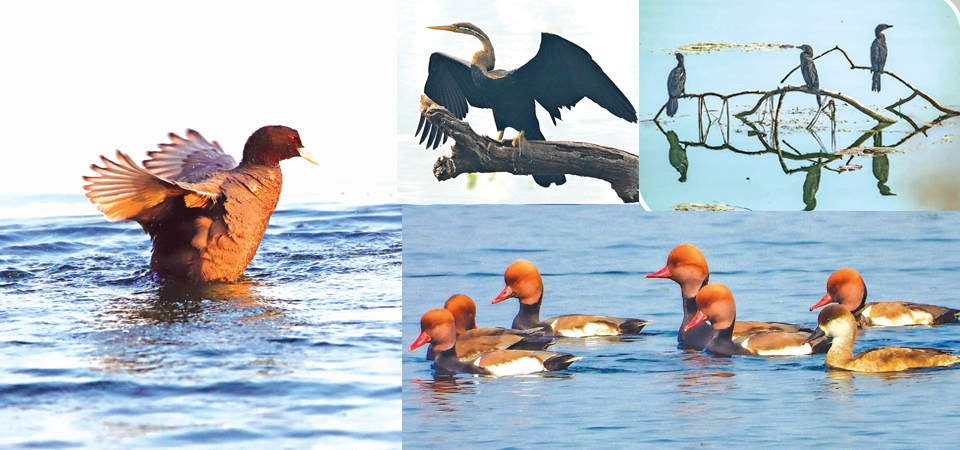Jagdishpur Lake Bird’s Paradise

Manoj Paudel
Jagadishpur Lake attracts plenty of birds and provides shelter to many local and migratory birds. With the start of every winter and summer season, different bird species arrive at this lake and its surrounding areas from far-off places.
Bar-headed Goose travels almost 9,350 metres high in the sky and arrives here in mid-September followed by Common Coot, and after two weeks, the Common Teel joins them.
At the same time, small groups of winter migratory birds such as Green Sandpiper, Common Greenshank and Temminck’s Stint arrive. They travel hundreds of miles to reach the lake area to hobnob with the suitable environment.
Plenty of Birds
These birds start arriving here in mid-September and their number keeps increasing at this lake, also named the “Bird’s Paradise”. Jagdishpur Lake is the only place where a large number of migratory birds arrive and stay for several months. Senior ornithologist Dr Hem Sagar Baral informed the birds migrate down to the south and southeast regions after the temperature starts dipping in northern parts of Russia, China and Mongolia.
Additional birds like Common Pochard, Tufted Duck, Little Grebe, Great Cormorant too get their traction to the lake. The increment in the arrival of birds like Common Teel, Gladwell, Red Crested Pochard, Eurasian Wigeon, Ruddy Shelduck to the lake rivets the environment of the lake and its surrounding areas, attracting a lot of visitors and bird watchers.
The flocks of these beautiful colourful birds create a scenic moment for bird watchers. The small movements and chirping of birds around the lake make the people more enchanted. Some of these birds complete their gestation cycle and grow their babies by nestling, egg-laying and returning to their original home.
Winter migrating birds usually arrive from Siberia, Mongolia, Russia and China, along with Turkmenistan and Kyrgyzstan from Central Asia, according to another ornithologist Mr Tika Giri. As the temperature decreases in the hills and sustenance are rare these birds choose to travel down to the terrain and vice versa.
The air distance travelled by them is about three to five thousand miles. They usually take 2/3 to 10 days to travel. Most of them directly arrive taking 3 to 4 days, whereas some choose to travel slowly taking a week. The duck species fly day and night to reach here. Among the one hundred and fifty species of winter migratory birds, sixty-five species arrive here. During winter- from September to late February, the lake is full of birds.
This is the only lake in Nepal which provides shelter to 20,000 to 22000 birds. This is the reason that calls for urgent action for the conservation and sustainable management of this lake.
According to IUCN (International Union for Conservation of Nature), among 888 bird species in Nepal, about 167 species of birds are found here. The 11 of the world’s rare species of birds can be seen easily in the lake and its surroundings, said the Bird’s Conservation Association.
Cotton Pygmy Goose, Garganey, Bar Headed Goose, Black Headed Ibis, Pheasant-tailed Jacana and Red-Crested Pochard can be seen in immense numbers. but the number of rare species of birds such as Northern Shoveler, Spot-billed Duck and Falcated Duck is decreasing here, said Dr Baral.
Higher Importance
Jagdishpur is the only lake where various kinds of birds can be seen in one place. This is the reason that the importance of the lake as a wetland is much higher, Herpetologist Prof. Dr Karan Bahadur Shah said.
At this place, birds road freely and get their food in abundance. That is why they love to travel here more often. This lake is an appropriate place for them that provides places to hide, play and reside. This lake is situated in Kapilvastu Municipality, ward number 9 and 10, which is nearly 11 kilometres away to the north of the district headquarters of Taulihawa.
It is the only artificial lake in Nepal and it has spread in around 157 hectares. Because of its bird population and impressive biodiversity, the lake was officially listed on the list of World Ramsar Sites in 2003. The plenty of birds are the reason that Jagdishpur Lake is famous in Nepal.
(Paudel is a photojournalist based in Kapilvastu district of southern Nepal)
Recent News

Do not make expressions casting dout on election: EC
14 Apr, 2022
CM Bhatta says may New Year 2079 BS inspire positive thinking
14 Apr, 2022
Three new cases, 44 recoveries in 24 hours
14 Apr, 2022
689 climbers of 84 teams so far acquire permits for climbing various peaks this spring season
14 Apr, 2022
How the rising cost of living crisis is impacting Nepal
14 Apr, 2022
US military confirms an interstellar meteor collided with Earth
14 Apr, 2022
Valneva Covid vaccine approved for use in UK
14 Apr, 2022
Chair Prachanda highlights need of unity among Maoist, Communist forces
14 Apr, 2022
Ranbir Kapoor and Alia Bhatt: Bollywood toasts star couple on wedding
14 Apr, 2022
President Bhandari confers decorations (Photo Feature)
14 Apr, 2022











